Research Paper: Gender-Based Violence in Canada (SOCI 2240)
VerifiedAdded on 2023/01/09
|7
|1638
|59
Report
AI Summary
This research paper delves into the multifaceted issue of gender-based violence (GBV) in Canada, exploring its various forms and impacts. The paper examines three key aspects of GBV: gender discrimination, sexual harassment, and domestic violence. It utilizes scholarly sources to analyze these practices, highlighting the systemic challenges faced by vulnerable groups such as women, Indigenous communities, and immigrant women. The report discusses the causes and consequences of gender discrimination, including wage gaps and cultural influences. It also explores the prevalence and effects of sexual harassment in the workplace and other settings, as well as the dynamics of domestic violence. The paper references laws and policies related to human rights and freedom in Canada, emphasizing the need for comprehensive strategies to address and mitigate GBV. The study draws on research from multiple sources to provide a comprehensive overview of the complexities surrounding gender-based violence in Canada.

Gender-based violence in Canada
Name
Course
Professor
Institution
Date
(
Name
Course
Professor
Institution
Date
(
Paraphrase This Document
Need a fresh take? Get an instant paraphrase of this document with our AI Paraphraser
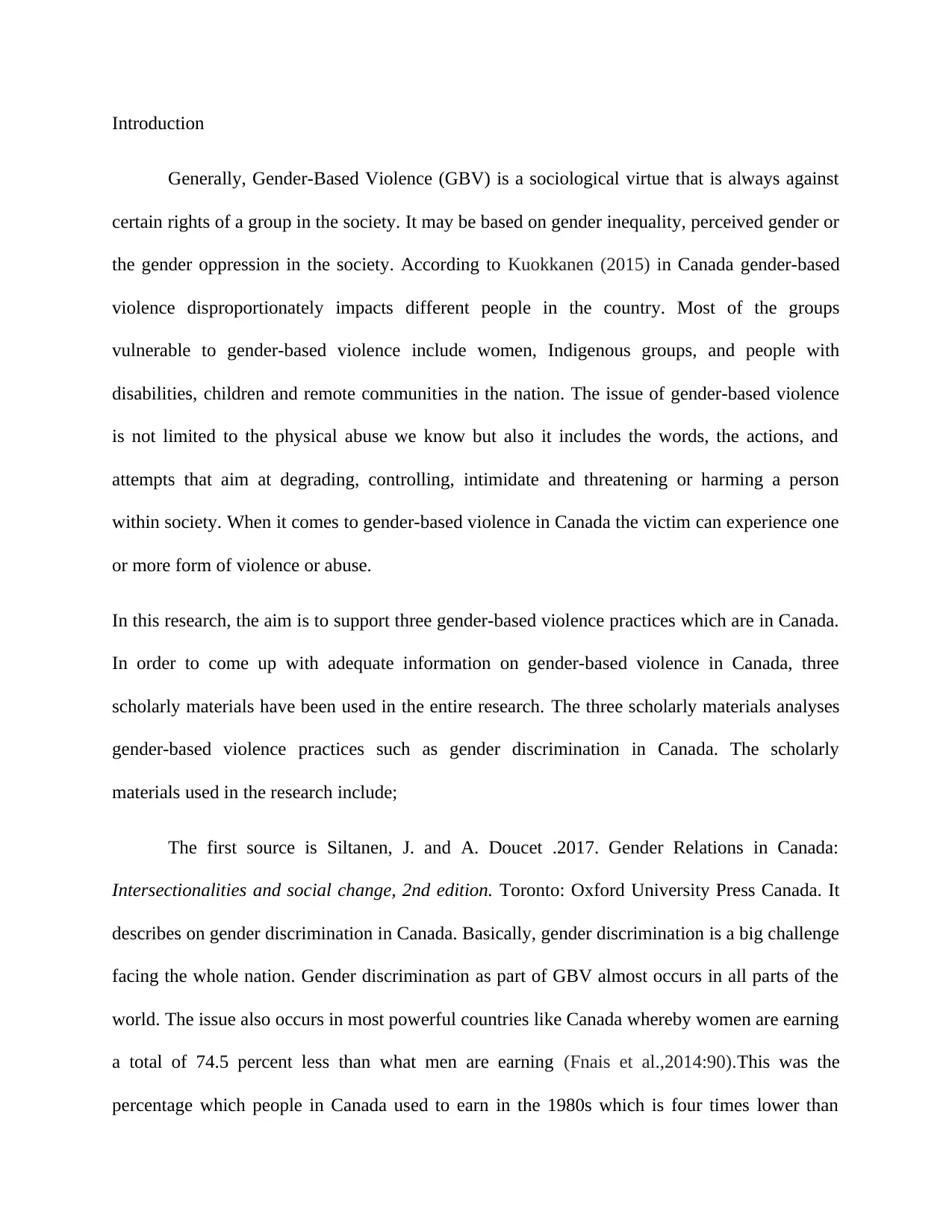
Introduction
Generally, Gender-Based Violence (GBV) is a sociological virtue that is always against
certain rights of a group in the society. It may be based on gender inequality, perceived gender or
the gender oppression in the society. According to Kuokkanen (2015) in Canada gender-based
violence disproportionately impacts different people in the country. Most of the groups
vulnerable to gender-based violence include women, Indigenous groups, and people with
disabilities, children and remote communities in the nation. The issue of gender-based violence
is not limited to the physical abuse we know but also it includes the words, the actions, and
attempts that aim at degrading, controlling, intimidate and threatening or harming a person
within society. When it comes to gender-based violence in Canada the victim can experience one
or more form of violence or abuse.
In this research, the aim is to support three gender-based violence practices which are in Canada.
In order to come up with adequate information on gender-based violence in Canada, three
scholarly materials have been used in the entire research. The three scholarly materials analyses
gender-based violence practices such as gender discrimination in Canada. The scholarly
materials used in the research include;
The first source is Siltanen, J. and A. Doucet .2017. Gender Relations in Canada:
Intersectionalities and social change, 2nd edition. Toronto: Oxford University Press Canada. It
describes on gender discrimination in Canada. Basically, gender discrimination is a big challenge
facing the whole nation. Gender discrimination as part of GBV almost occurs in all parts of the
world. The issue also occurs in most powerful countries like Canada whereby women are earning
a total of 74.5 percent less than what men are earning (Fnais et al.,2014:90).This was the
percentage which people in Canada used to earn in the 1980s which is four times lower than
Generally, Gender-Based Violence (GBV) is a sociological virtue that is always against
certain rights of a group in the society. It may be based on gender inequality, perceived gender or
the gender oppression in the society. According to Kuokkanen (2015) in Canada gender-based
violence disproportionately impacts different people in the country. Most of the groups
vulnerable to gender-based violence include women, Indigenous groups, and people with
disabilities, children and remote communities in the nation. The issue of gender-based violence
is not limited to the physical abuse we know but also it includes the words, the actions, and
attempts that aim at degrading, controlling, intimidate and threatening or harming a person
within society. When it comes to gender-based violence in Canada the victim can experience one
or more form of violence or abuse.
In this research, the aim is to support three gender-based violence practices which are in Canada.
In order to come up with adequate information on gender-based violence in Canada, three
scholarly materials have been used in the entire research. The three scholarly materials analyses
gender-based violence practices such as gender discrimination in Canada. The scholarly
materials used in the research include;
The first source is Siltanen, J. and A. Doucet .2017. Gender Relations in Canada:
Intersectionalities and social change, 2nd edition. Toronto: Oxford University Press Canada. It
describes on gender discrimination in Canada. Basically, gender discrimination is a big challenge
facing the whole nation. Gender discrimination as part of GBV almost occurs in all parts of the
world. The issue also occurs in most powerful countries like Canada whereby women are earning
a total of 74.5 percent less than what men are earning (Fnais et al.,2014:90).This was the
percentage which people in Canada used to earn in the 1980s which is four times lower than
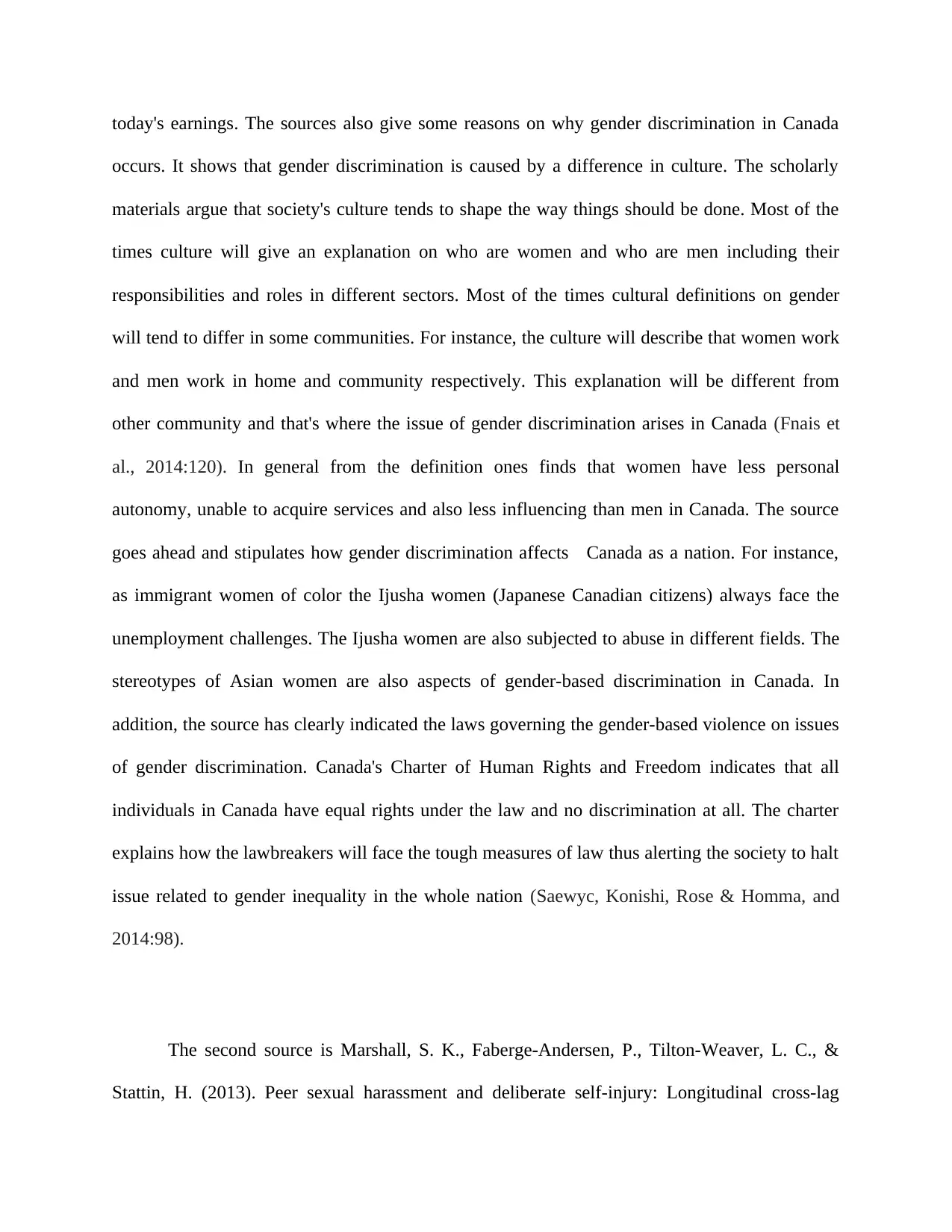
today's earnings. The sources also give some reasons on why gender discrimination in Canada
occurs. It shows that gender discrimination is caused by a difference in culture. The scholarly
materials argue that society's culture tends to shape the way things should be done. Most of the
times culture will give an explanation on who are women and who are men including their
responsibilities and roles in different sectors. Most of the times cultural definitions on gender
will tend to differ in some communities. For instance, the culture will describe that women work
and men work in home and community respectively. This explanation will be different from
other community and that's where the issue of gender discrimination arises in Canada (Fnais et
al., 2014:120). In general from the definition ones finds that women have less personal
autonomy, unable to acquire services and also less influencing than men in Canada. The source
goes ahead and stipulates how gender discrimination affects Canada as a nation. For instance,
as immigrant women of color the Ijusha women (Japanese Canadian citizens) always face the
unemployment challenges. The Ijusha women are also subjected to abuse in different fields. The
stereotypes of Asian women are also aspects of gender-based discrimination in Canada. In
addition, the source has clearly indicated the laws governing the gender-based violence on issues
of gender discrimination. Canada's Charter of Human Rights and Freedom indicates that all
individuals in Canada have equal rights under the law and no discrimination at all. The charter
explains how the lawbreakers will face the tough measures of law thus alerting the society to halt
issue related to gender inequality in the whole nation (Saewyc, Konishi, Rose & Homma, and
2014:98).
The second source is Marshall, S. K., Faberge-Andersen, P., Tilton-Weaver, L. C., &
Stattin, H. (2013). Peer sexual harassment and deliberate self-injury: Longitudinal cross-lag
occurs. It shows that gender discrimination is caused by a difference in culture. The scholarly
materials argue that society's culture tends to shape the way things should be done. Most of the
times culture will give an explanation on who are women and who are men including their
responsibilities and roles in different sectors. Most of the times cultural definitions on gender
will tend to differ in some communities. For instance, the culture will describe that women work
and men work in home and community respectively. This explanation will be different from
other community and that's where the issue of gender discrimination arises in Canada (Fnais et
al., 2014:120). In general from the definition ones finds that women have less personal
autonomy, unable to acquire services and also less influencing than men in Canada. The source
goes ahead and stipulates how gender discrimination affects Canada as a nation. For instance,
as immigrant women of color the Ijusha women (Japanese Canadian citizens) always face the
unemployment challenges. The Ijusha women are also subjected to abuse in different fields. The
stereotypes of Asian women are also aspects of gender-based discrimination in Canada. In
addition, the source has clearly indicated the laws governing the gender-based violence on issues
of gender discrimination. Canada's Charter of Human Rights and Freedom indicates that all
individuals in Canada have equal rights under the law and no discrimination at all. The charter
explains how the lawbreakers will face the tough measures of law thus alerting the society to halt
issue related to gender inequality in the whole nation (Saewyc, Konishi, Rose & Homma, and
2014:98).
The second source is Marshall, S. K., Faberge-Andersen, P., Tilton-Weaver, L. C., &
Stattin, H. (2013). Peer sexual harassment and deliberate self-injury: Longitudinal cross-lag
⊘ This is a preview!⊘
Do you want full access?
Subscribe today to unlock all pages.

Trusted by 1+ million students worldwide
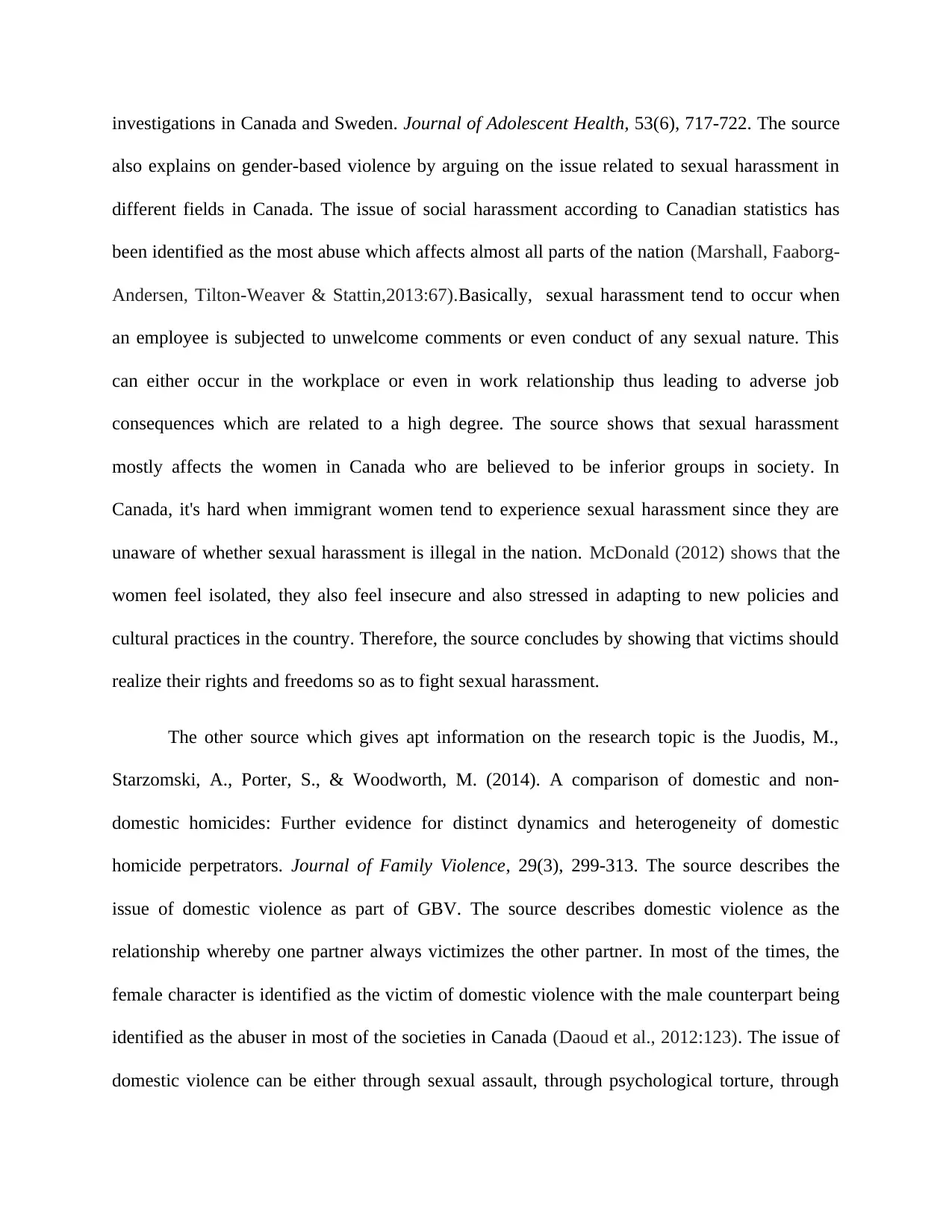
investigations in Canada and Sweden. Journal of Adolescent Health, 53(6), 717-722. The source
also explains on gender-based violence by arguing on the issue related to sexual harassment in
different fields in Canada. The issue of social harassment according to Canadian statistics has
been identified as the most abuse which affects almost all parts of the nation (Marshall, Faaborg-
Andersen, Tilton-Weaver & Stattin,2013:67).Basically, sexual harassment tend to occur when
an employee is subjected to unwelcome comments or even conduct of any sexual nature. This
can either occur in the workplace or even in work relationship thus leading to adverse job
consequences which are related to a high degree. The source shows that sexual harassment
mostly affects the women in Canada who are believed to be inferior groups in society. In
Canada, it's hard when immigrant women tend to experience sexual harassment since they are
unaware of whether sexual harassment is illegal in the nation. McDonald (2012) shows that the
women feel isolated, they also feel insecure and also stressed in adapting to new policies and
cultural practices in the country. Therefore, the source concludes by showing that victims should
realize their rights and freedoms so as to fight sexual harassment.
The other source which gives apt information on the research topic is the Juodis, M.,
Starzomski, A., Porter, S., & Woodworth, M. (2014). A comparison of domestic and non-
domestic homicides: Further evidence for distinct dynamics and heterogeneity of domestic
homicide perpetrators. Journal of Family Violence, 29(3), 299-313. The source describes the
issue of domestic violence as part of GBV. The source describes domestic violence as the
relationship whereby one partner always victimizes the other partner. In most of the times, the
female character is identified as the victim of domestic violence with the male counterpart being
identified as the abuser in most of the societies in Canada (Daoud et al., 2012:123). The issue of
domestic violence can be either through sexual assault, through psychological torture, through
also explains on gender-based violence by arguing on the issue related to sexual harassment in
different fields in Canada. The issue of social harassment according to Canadian statistics has
been identified as the most abuse which affects almost all parts of the nation (Marshall, Faaborg-
Andersen, Tilton-Weaver & Stattin,2013:67).Basically, sexual harassment tend to occur when
an employee is subjected to unwelcome comments or even conduct of any sexual nature. This
can either occur in the workplace or even in work relationship thus leading to adverse job
consequences which are related to a high degree. The source shows that sexual harassment
mostly affects the women in Canada who are believed to be inferior groups in society. In
Canada, it's hard when immigrant women tend to experience sexual harassment since they are
unaware of whether sexual harassment is illegal in the nation. McDonald (2012) shows that the
women feel isolated, they also feel insecure and also stressed in adapting to new policies and
cultural practices in the country. Therefore, the source concludes by showing that victims should
realize their rights and freedoms so as to fight sexual harassment.
The other source which gives apt information on the research topic is the Juodis, M.,
Starzomski, A., Porter, S., & Woodworth, M. (2014). A comparison of domestic and non-
domestic homicides: Further evidence for distinct dynamics and heterogeneity of domestic
homicide perpetrators. Journal of Family Violence, 29(3), 299-313. The source describes the
issue of domestic violence as part of GBV. The source describes domestic violence as the
relationship whereby one partner always victimizes the other partner. In most of the times, the
female character is identified as the victim of domestic violence with the male counterpart being
identified as the abuser in most of the societies in Canada (Daoud et al., 2012:123). The issue of
domestic violence can be either through sexual assault, through psychological torture, through
Paraphrase This Document
Need a fresh take? Get an instant paraphrase of this document with our AI Paraphraser
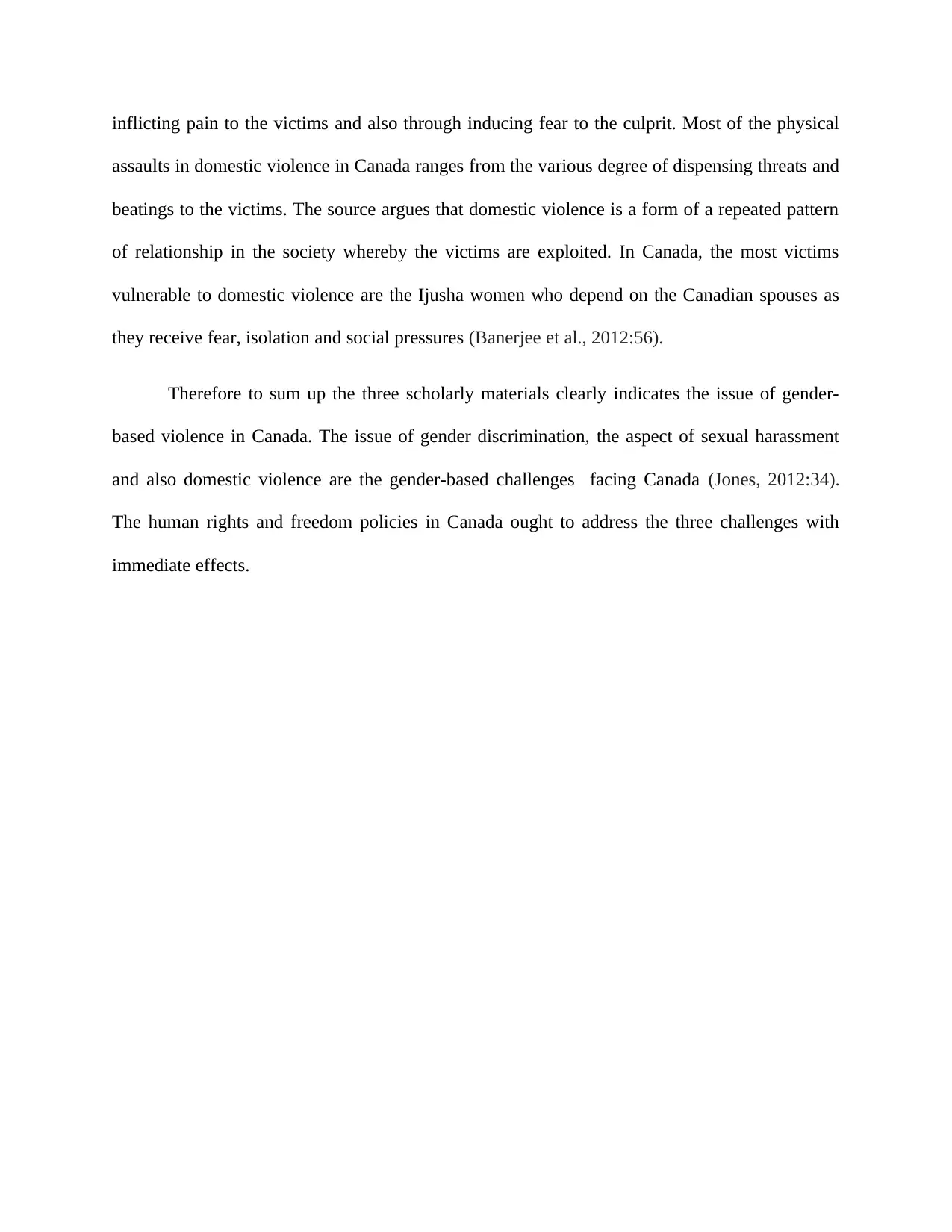
inflicting pain to the victims and also through inducing fear to the culprit. Most of the physical
assaults in domestic violence in Canada ranges from the various degree of dispensing threats and
beatings to the victims. The source argues that domestic violence is a form of a repeated pattern
of relationship in the society whereby the victims are exploited. In Canada, the most victims
vulnerable to domestic violence are the Ijusha women who depend on the Canadian spouses as
they receive fear, isolation and social pressures (Banerjee et al., 2012:56).
Therefore to sum up the three scholarly materials clearly indicates the issue of gender-
based violence in Canada. The issue of gender discrimination, the aspect of sexual harassment
and also domestic violence are the gender-based challenges facing Canada (Jones, 2012:34).
The human rights and freedom policies in Canada ought to address the three challenges with
immediate effects.
assaults in domestic violence in Canada ranges from the various degree of dispensing threats and
beatings to the victims. The source argues that domestic violence is a form of a repeated pattern
of relationship in the society whereby the victims are exploited. In Canada, the most victims
vulnerable to domestic violence are the Ijusha women who depend on the Canadian spouses as
they receive fear, isolation and social pressures (Banerjee et al., 2012:56).
Therefore to sum up the three scholarly materials clearly indicates the issue of gender-
based violence in Canada. The issue of gender discrimination, the aspect of sexual harassment
and also domestic violence are the gender-based challenges facing Canada (Jones, 2012:34).
The human rights and freedom policies in Canada ought to address the three challenges with
immediate effects.
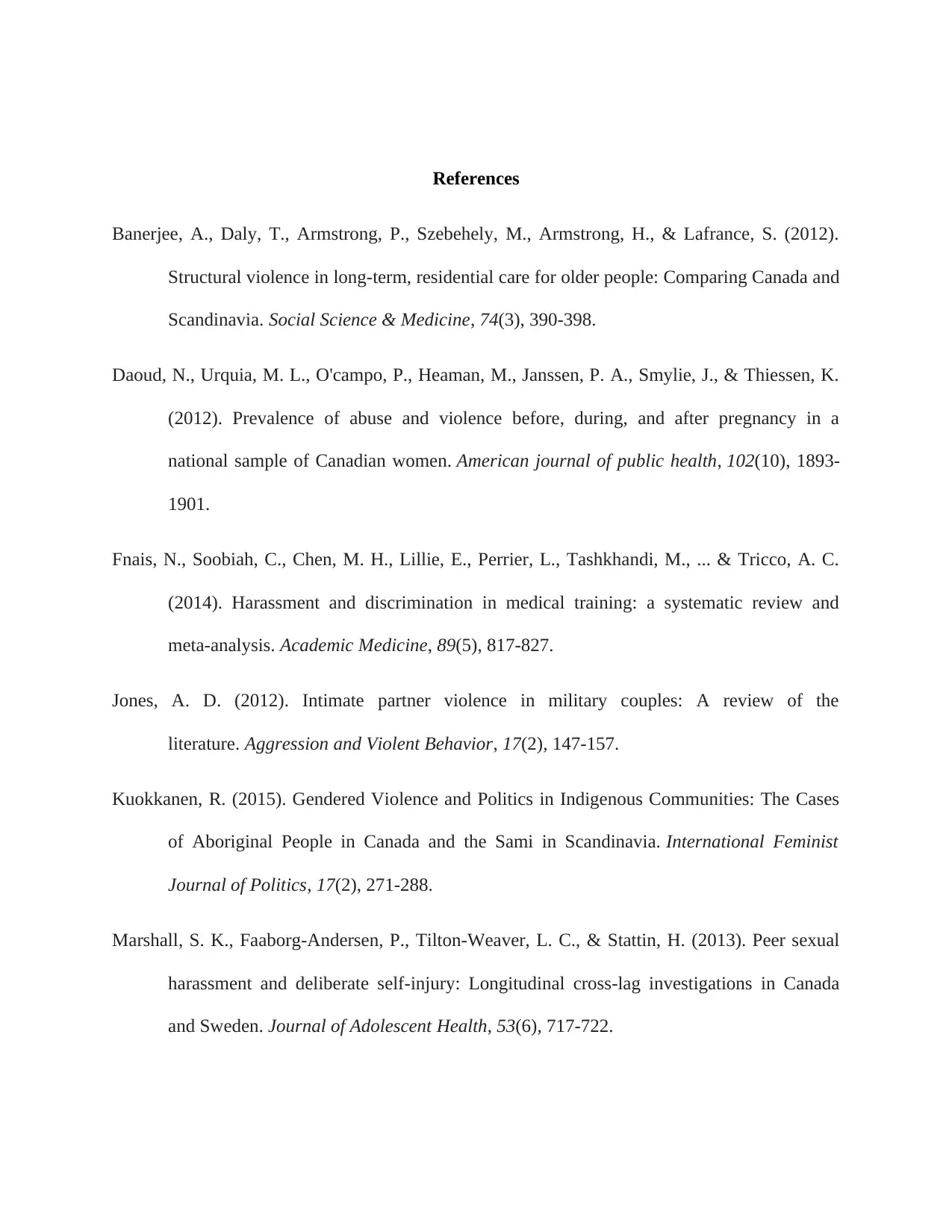
References
Banerjee, A., Daly, T., Armstrong, P., Szebehely, M., Armstrong, H., & Lafrance, S. (2012).
Structural violence in long-term, residential care for older people: Comparing Canada and
Scandinavia. Social Science & Medicine, 74(3), 390-398.
Daoud, N., Urquia, M. L., O'campo, P., Heaman, M., Janssen, P. A., Smylie, J., & Thiessen, K.
(2012). Prevalence of abuse and violence before, during, and after pregnancy in a
national sample of Canadian women. American journal of public health, 102(10), 1893-
1901.
Fnais, N., Soobiah, C., Chen, M. H., Lillie, E., Perrier, L., Tashkhandi, M., ... & Tricco, A. C.
(2014). Harassment and discrimination in medical training: a systematic review and
meta-analysis. Academic Medicine, 89(5), 817-827.
Jones, A. D. (2012). Intimate partner violence in military couples: A review of the
literature. Aggression and Violent Behavior, 17(2), 147-157.
Kuokkanen, R. (2015). Gendered Violence and Politics in Indigenous Communities: The Cases
of Aboriginal People in Canada and the Sami in Scandinavia. International Feminist
Journal of Politics, 17(2), 271-288.
Marshall, S. K., Faaborg-Andersen, P., Tilton-Weaver, L. C., & Stattin, H. (2013). Peer sexual
harassment and deliberate self-injury: Longitudinal cross-lag investigations in Canada
and Sweden. Journal of Adolescent Health, 53(6), 717-722.
Banerjee, A., Daly, T., Armstrong, P., Szebehely, M., Armstrong, H., & Lafrance, S. (2012).
Structural violence in long-term, residential care for older people: Comparing Canada and
Scandinavia. Social Science & Medicine, 74(3), 390-398.
Daoud, N., Urquia, M. L., O'campo, P., Heaman, M., Janssen, P. A., Smylie, J., & Thiessen, K.
(2012). Prevalence of abuse and violence before, during, and after pregnancy in a
national sample of Canadian women. American journal of public health, 102(10), 1893-
1901.
Fnais, N., Soobiah, C., Chen, M. H., Lillie, E., Perrier, L., Tashkhandi, M., ... & Tricco, A. C.
(2014). Harassment and discrimination in medical training: a systematic review and
meta-analysis. Academic Medicine, 89(5), 817-827.
Jones, A. D. (2012). Intimate partner violence in military couples: A review of the
literature. Aggression and Violent Behavior, 17(2), 147-157.
Kuokkanen, R. (2015). Gendered Violence and Politics in Indigenous Communities: The Cases
of Aboriginal People in Canada and the Sami in Scandinavia. International Feminist
Journal of Politics, 17(2), 271-288.
Marshall, S. K., Faaborg-Andersen, P., Tilton-Weaver, L. C., & Stattin, H. (2013). Peer sexual
harassment and deliberate self-injury: Longitudinal cross-lag investigations in Canada
and Sweden. Journal of Adolescent Health, 53(6), 717-722.
⊘ This is a preview!⊘
Do you want full access?
Subscribe today to unlock all pages.

Trusted by 1+ million students worldwide
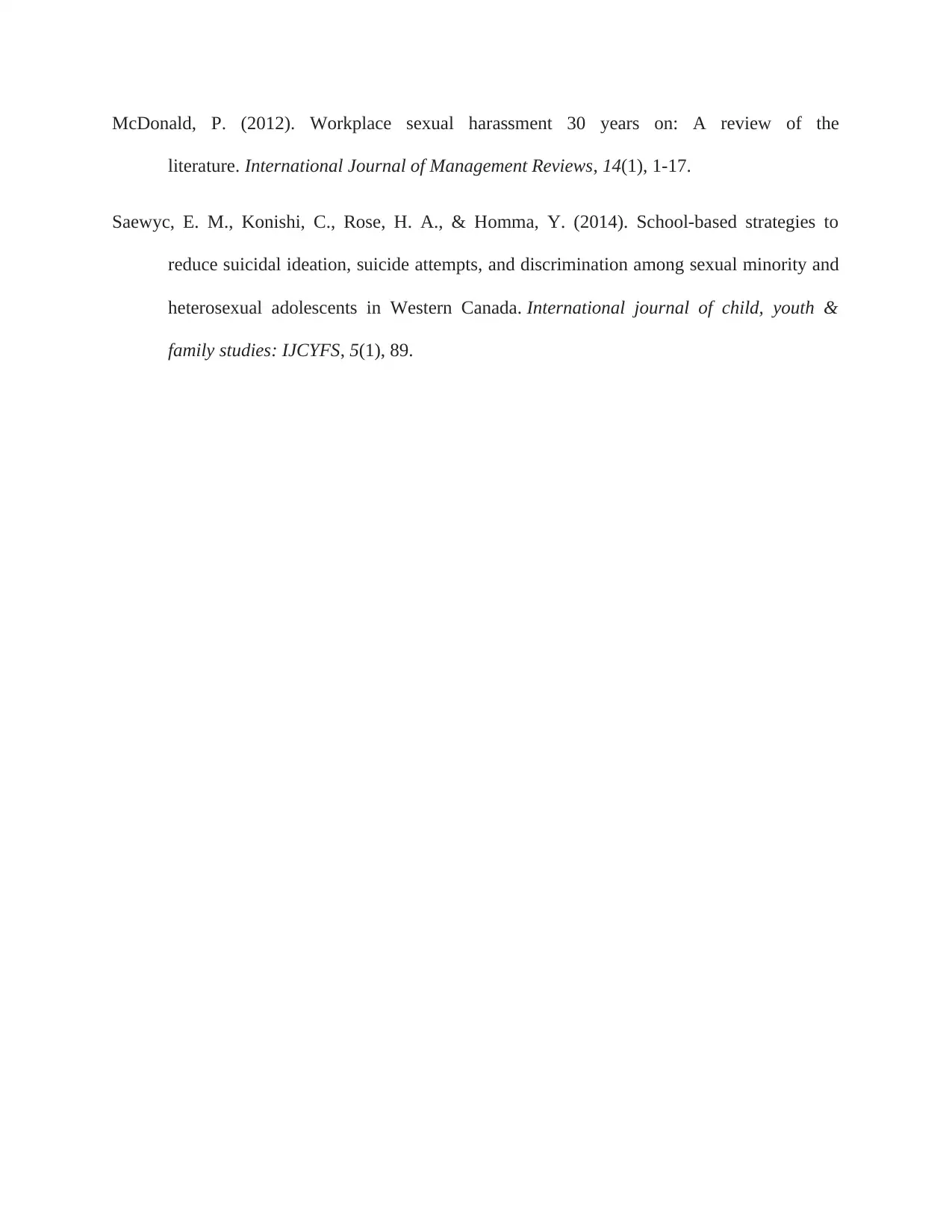
McDonald, P. (2012). Workplace sexual harassment 30 years on: A review of the
literature. International Journal of Management Reviews, 14(1), 1-17.
Saewyc, E. M., Konishi, C., Rose, H. A., & Homma, Y. (2014). School-based strategies to
reduce suicidal ideation, suicide attempts, and discrimination among sexual minority and
heterosexual adolescents in Western Canada. International journal of child, youth &
family studies: IJCYFS, 5(1), 89.
literature. International Journal of Management Reviews, 14(1), 1-17.
Saewyc, E. M., Konishi, C., Rose, H. A., & Homma, Y. (2014). School-based strategies to
reduce suicidal ideation, suicide attempts, and discrimination among sexual minority and
heterosexual adolescents in Western Canada. International journal of child, youth &
family studies: IJCYFS, 5(1), 89.
1 out of 7
Related Documents
Your All-in-One AI-Powered Toolkit for Academic Success.
+13062052269
info@desklib.com
Available 24*7 on WhatsApp / Email
![[object Object]](/_next/static/media/star-bottom.7253800d.svg)
Unlock your academic potential
Copyright © 2020–2025 A2Z Services. All Rights Reserved. Developed and managed by ZUCOL.




